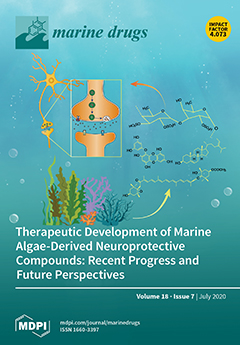The geographic position, highly fluctuating sea temperatures and hypersalinity make Persian Gulf an extreme environment. Although this unique environment has high biodiversity dominated by invertebrates, its potential in marine biodiscovery has largely remained untapped. Herein, we aimed at a detailed analysis of the metabolome and bioactivity profiles of the marine sponge
Axinella sinoxea collected from the northeast coast of the Persian Gulf in Iran. The crude extract and its Kupchan subextracts were tested in multiple in-house bioassays, and the crude extract and its CHCl
3-soluble portion showed in vitro antibacterial activity against Methicillin-resistant
Staphylococcus aureus (MRSA) and
Enterococcus faecium (Efm). A molecular networking (MN)-based dereplication strategy by UPLC-MS/MS revealed the presence of phospholipids and steroids, while
1H NMR spectroscopy indicated the presence of additional metabolites, such as diketopiperazines (DKPs). Integrated MN and
1H NMR analyses on both the crude and CHCl
3 extracts combined with an antibacterial activity-guided isolation approach afforded eight metabolites: a new diketopiperazine, (-)-cyclo(
L-
trans-Hyp-
L-Ile) (
8); a known diketopiperazine, cyclo(
L-
trans-Hyp-
L-Phe) (
7); two known phospholipids, 1-
O-hexadecyl-
sn-glycero-3-phosphocholine (
1) and 1-
O-octadecanoyl-
sn-glycero-3-phosphocholine (
2); two known steroids, 3β-hydroxycholest-5-ene-7,24-dione (
3) and (22
E)-3β-hydroxycholesta-5,22-diene-7,24-dione (
4); two known monoterpenes, loliolide (
5) and 5-
epi-loliolide (
6). The chemical structures of the isolates were elucidated by a combination of NMR spectroscopy, HRMS and [α]
D analyses. All compounds were tested against MRSA and Efm, and compound
3 showed moderate antibacterial activity against MRSA (IC
50 value 70 μg/mL). This is the first study that has dealt with chemical and bioactivity profiling of
A. sinoxea leading to isolation and characterization of pure sponge metabolites.
Full article






